It was the biggest shake-up of Australia’s media landscape in decades. A $4.2 billion deal that drew serious concerns over media diversity in what was already one of the most highly concentrated media ownership landscapes on the planet. Australians were assured they needn’t worry – TV giant Nine Entertainment Co. would be bound by Fairfax’s Media’s storied Independence Charter. There is only one problem. Anthony Klan reports.
Appreciate our quality journalism? Please donate here
EXCLUSIVE
Nine Entertainment’s board never signed the independence charter that governed Fairfax Media, the 180 year-old media company it took over in a mega $4.2 billion merger two years ago.
The Klaxon can exclusively reveal Nine has failed to sign – or to ratify in any legally binding way – the storied charter, which underpinned the editorial integrity of several of Australia’s biggest and most influential newspapers – including the The Sydney Morning Herald, The Age and The Australian Financial Review – for the past three decades.
That is despite Nine bluffing for the past two years and implying that it had done so.
The explosive revelations go to the heart of the independence of media in Australia and come just three weeks after a senate inquiry into media ownership was called.
Nine spokesman Nic Christensen confirmed Nine had never signed the Fairfax Charter of Editorial Independence.
That confirmation came just over two weeks ago, and was in response to a series of questions The Klaxon put to Nine management and its board of directors.
Hours after that confirmation, Nine CEO Hugh Marks announced his shock resignation.
In subsequent correspondence with us, Nine has failed to provide a single document – or any written evidence whatsoever – showing that it is in any way bound by the former Fairfax independence charter.
The Fairfax Charter of Editorial Independence has long been a bedrock of the Australian media landscape, especially given the size and influence of the Fairfax papers and the nation’s extremely concentrated media ownership.
The charter required Fairfax journalists be truly “independent” of who owned the newspapers they worked for.
It was signed by staff of The Age in March 1988, and by the board of John Fairfax Limited (the company later changed its name to Fairfax Media) two months later, in May 1988.
It was broadened in 1990 and from February, 1991 the Fairfax Charter of Editorial Independence covered staff at The Sunday Age, The Sydney Morning Herald, the Sun-Herald and The Australian Financial Review.
The charter stated, among other things, that journalists at Fairfax publications must report “fairly, fully and regardless of any commercial, political or personal interests,” including those of “any proprietors, shareholders or board members”.
It stated that management couldn’t force journalists to do anything in breach of the Australian journalism code of ethics, and that “full editorial control of the newspapers” would vest with the newspapers’ editors.
“The editors alone shall determine the daily editorial content of the newspapers,” the Fairfax Charter of Editorial Independence stated.
“Until Peter Costello…formally signs a binding document that commits Nine to adopting the charter of independence, our members will continue to be concerned and sceptical about how genuine Nine’s commitment to editorial independence really is” — MEAA’s Marcus Strom, 2018
The importance of the charter was seen to be of such importance that in 1991 it brought together two of Australia’s most famous political rivals, Gough Whitlam and his nemesis Malcom Fraser.
The pair attended an October 1991 rally, organised by The Age Independence Committee, and urged the then ALP Hawke Government to do everything it could to prevent further media concentration.
The existence of a charter is important for many reasons.
At a practical level, for example, if a reporter were to refuse directions because while legal, they were not inline with the charter, they would likely have little recourse if they were subsequently fired for not following those directions.
Yet not only has Nine not signed the charter, or put anything in its place, the charter doesn’t actually exist.
At least not in any real or legal sense.
It was a signed agreement between journalists at the then Fairfax papers and the Fairfax board.
On December 7, 2018, when Nine took over Fairfax, the Fairfax board ceased to exist.
As a result, so too did the independence charter.
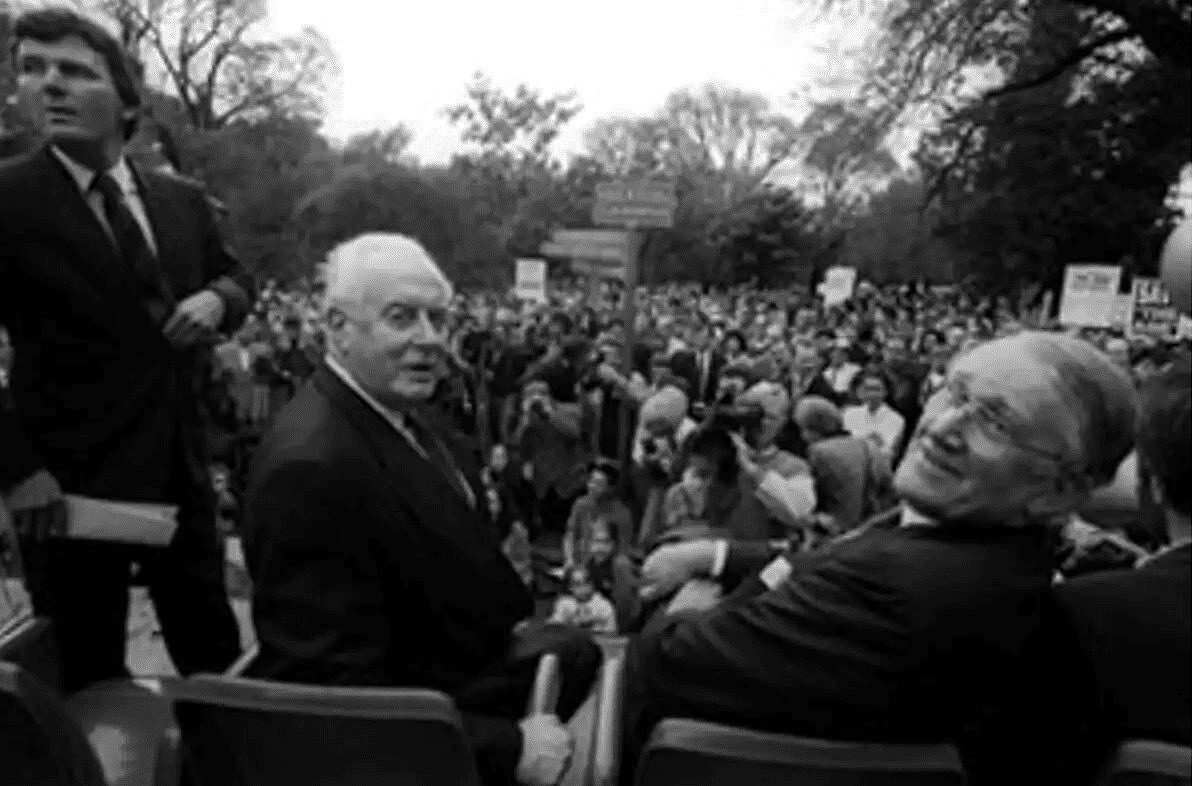
Gough Whitlam and Malcolm Fraser join forces in 1991 in support of The Age’s charter of independence. Source: Supplied.
Weasel Words
On July 26, 2018, under Nine chairman Peter Costello, a senior LNP figure and former Federal Treasurer, Nine announced its plans to take over Fairfax.
Ten months earlier, the Federal Coalition, under Prime Minister Malcom Turnbull, had succeeded in its push to water down media ownership laws, a goal it had been pursuing since it was elected in 2013.
The changes meant Nine could now buy Fairfax.
Before the changes, the long-standing “two-out-of-three” rule meant media moguls could not own television, radio and newspapers in the one market.
Nine had television and radio – Nine Radio (previously called Macquarie Media) owns many stations including 2GB, 4BC, 3AW and 6PR.
Now it could finally own newspapers too.
Allowing Nine to buy Fairfax had long been seen as a key motive behind the Coalition’s campaign to scrap the decades-old ownership restrictions.
It has delivered Nine, already a major media player, enormous influence over the nation’s media and social discourse.
Nine’s July 2018 takeover announcement raised serious concerns.
Alongside the fact that it would further erode Australia’s already woeful media ownership diversity, the news sparks widespread concerns that the quality of the Fairfax mastheads would diminish under Nine and be subject to political interference and improper commercial influence.
Nine was well aware of these concerns and the danger they posed to it getting the Fairfax takeover the line.
It made a number of statements to hose down the concerns.
The closest thing to suggesting any actual connection whatsoever between Nine and the Fairfax Charter of Independence is a two-sentence statement on page 30 of Nine’s 354-page “Fairfax scheme” takeover document, released to the market on October 12, 2018.
It says that under the takeover the Fairfax papers will be owned by Nine.
It gives a description of the Nine Charter of Editorial Independence.
Then it says Nine’s Charter of Editorial Independence “has been unanimously endorsed by the Nine Board”.
That statement has underpinned Nine’s monstrous bluff.
And Nine continues to hold it up as alleged evidence it is actually bound by the charter.
The statement was the single piece of written evidence that Nine could provide us when we pushed Nine (repeatedly) in recent weeks to provide us with any written evidence whatsoever that there was a connection between Nine and the charter.
But the statement that Nine’s board had “endorsed” the Fairfax Charter of Independence meant little to nothing on October 12, 2018.
At the time, Nine did not own or have any control over Fairfax, and it had zero legal or ethical relationship with Fairfax reporters.
In other words, any statement Nine made about honouring, “adopting” or “endorsing” the Charter of Independence before it actually owned Fairfax was effectively meaningless.
Nine’s takeover of Fairfax happened in December 7, 2018.
We asked Nine when its board had made the “decision” about the Fairfax charter?
“It occurred at a board meeting prior to the merger,” Christensen wrote.
Nine’s wrangling with the truth and omissions regarding the Fairfax independence charter date back to the announcement of the takeover plans in mid-2018.
At that time CEO Marks said Nine was “more than happy to adopt the principles of the independence charter”.
However he did not say Nine would actually sign it.
When asked on ABC’s 7.30 shortly afterwards, chairman Costello skirted around the issue.
“In a further media interview today, Costello was silent on the charter of independence,” it was reported at the time.
The journalists union, the Media Entertainment and Arts Alliance (MEAA), was unequivocal.
“Until Peter Costello…formally signs a binding document that commits Nine to adopting the charter of independence, our members will continue to be concerned and sceptical about how genuine Nine’s commitment to editorial independence really is,” MEAA president Marcus Strom said at the time.
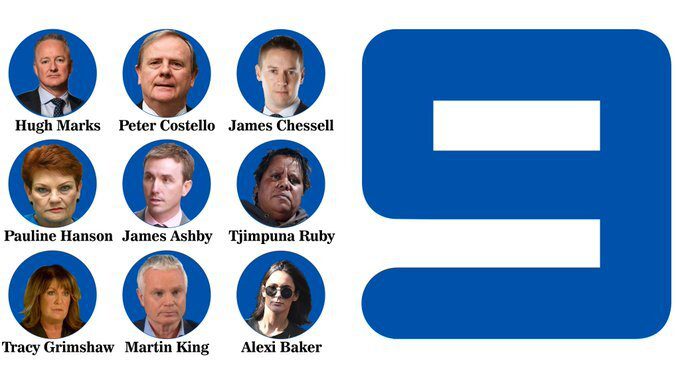
Nine’s The Matey Bunch. The one where Hanson climbs Uluru. Source: HS
Sirens
Alarm bells that Nine may never have actually signed the Fairfax charter sounded at The Klaxon last month.
We had exposed that Nine’s A Current Affair had orchestrated the stunt involving far-right Senator climbing on Uluru, ostensibly as part of a “protest” against the then upcoming closure of the sacred site to climbers.
The Klaxon revealed that despite assurances from Nine, including a public statement from A Current Affair Host Tracey Grimshaw, Nine had deeply misled the public about its involvement in the stunt, which involved its reporter Martin King and Hanson climbing on Uluru against the wishes of its custodians and federal agency Parks Australia.
Nine had instead obtained alleged “approval” from an indigenous “group” that existed only on Facebook, and which we revealed was set up just one week before Nine kicked off its divisive stunt.
Nine allegedly then gagged that indigenous group.
Our expose caused a backlash over Nine’s “disgraceful”, “shocking” and “unconscionable” behaviour, including from a string of high-profile and respected journalists who demanded answers.
Despite the Hanson-Uluru expose being widely covered by media – including by The Guardian, The West Australian and the Daily Mail – not one word of it appeared in any of the former Fairfax newspapers.
That was despite The Sydney Morning Herald and The Age having run “news” of Hanson’s Uluru climb last year, both papers editorialising about her climb last October, and the fact that both papers continue to carry the advertising slogan “Independent. Always.”.
Just like Hanson’s Uluru climb, it appears the “signing” of the Fairfax independence was a monumental stitch up orchestrated by Nine Entertainment.
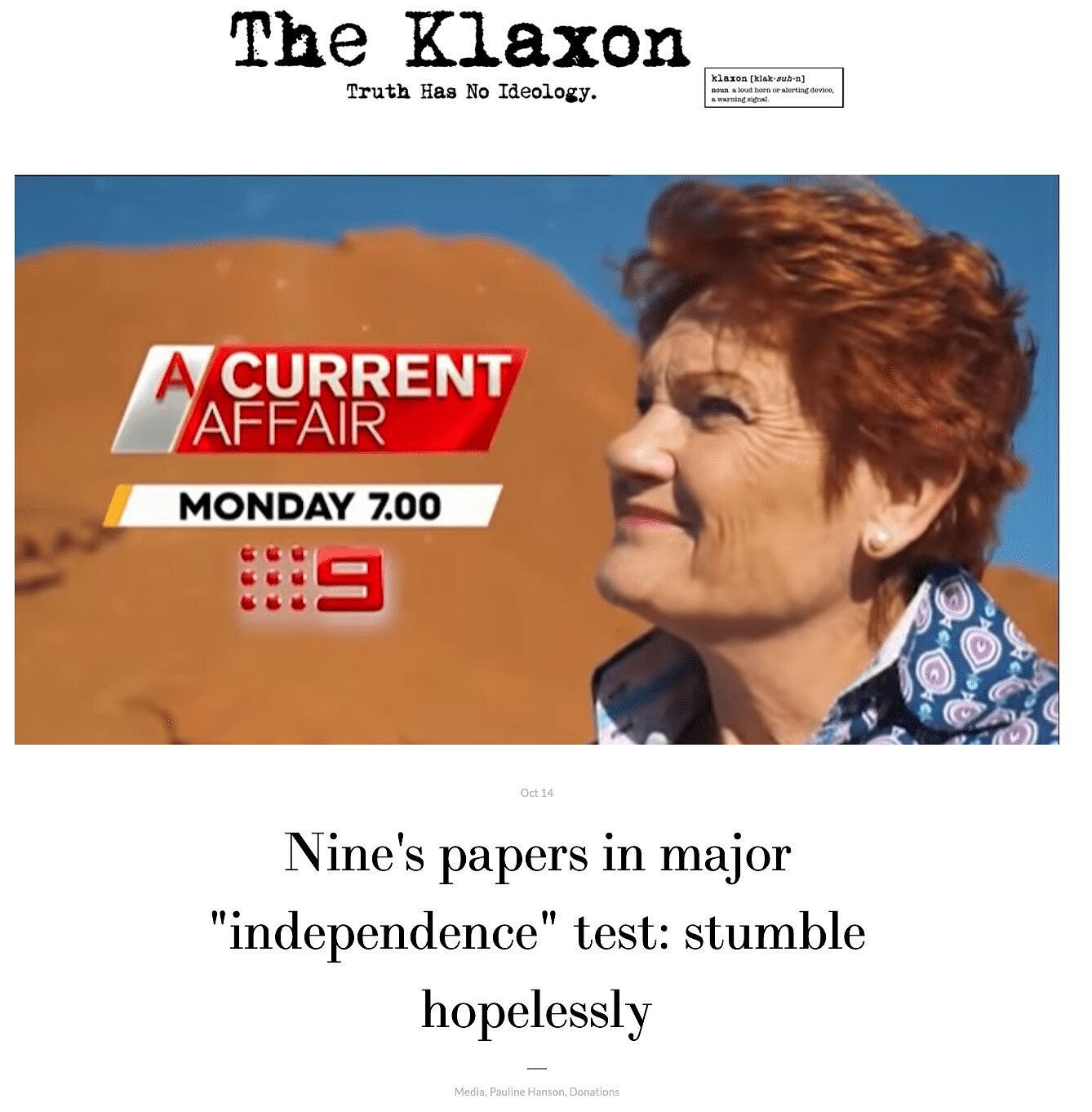
Revelations that Nine orchestrated the Hanson-Uluru stunt shone the spotlight on the alleged “independence” of its newspapers. Source: The Klaxon
Early in the afternoon of Friday November 13, two weeks ago, The Klaxon wrote to Nine.
We wanted to know, simply, whether Nine had ever in fact signed the Fairfax Charter of Editorial Independence.
At 9.11pm that night Nine spokesman Nic Christensen responded.
“I’d direct you to the multiple statements we made at the time of the merger about the board agreeing to sign up to the Fairfax Charter of Independence,” he wrote.
We persisted.
While it is true that Nine has made several vague statements regarding the Fairfax charter – that’s a matter of record – but we had not seen any evidence, anywhere, that Nine had actually signed it.
We asked again – was the Fairfax charter ever actually signed by Nine?
At 10.25pm on that Friday night the response came back.
No.
The following morning, a Saturday, Nine chairman Costello called an emergency meeting of Nine’s board members via video conference.
Hours later, Nine CEO Marks announced his shock resignation.
Nine’s annual general meeting – where succession matters are dealt with – had been held just two days earlier.
No mention had been made of Marks leaving Nine, or that he had anything other than the full support of Nine’s board.
Nine has given no explanation for Marks’s departure.
Marks, who is unmarried, has said it was related to a relationship he was in with a former Nine senior executive Alexi Baker.
Baker had reported to Marks as managing director of commercial, before she resigned on October 1 so their newly-formed relationship could continue without causing any governance concerns.
Nine chairman Costello has repeatedly declined to comment when asked by The Klaxon why Marks had left Nine.
This raises serious governance concerns at the $4.2 billion company.
If there was any wrongdoing, or suggestions of wrongdoing or failures by Marks, CEO for five years and on Nine’s board since February 2013 before his shock resignation, investors need to know to help ensure the appropriate steps are taken to help prevent that failure, or those failures, from happening again.
When Nine took over Fairfax the Fairfax board was dismantled.
Three people who had been on the Fairfax board, Mickie Rosen, Nick Falloon and Patrick Allaway, joined the Nine board after the takeover.
Costello declined to comment when asked whether Rosen, Falloon and Allaway had been aware that Nine had never actually signed the Fairfax Charter of Editorial Independence – or ratified it in any legally binding way – before The Klaxon approached Nine about the matter on Friday, November 13.
The second response from Nine came at 10.25pm.
“Each new board doesn’t physically sign it,” Christensen wrote.
This is incorrect.
In fact, not only was the former Fairfax charter signed by the Fairfax board (and so remained in place under Fairfax was shut down) The Age Independence Committee has previously made expressly clear the requirement that it be signed by any new owner of the newspapers.
“The charter was signed by the then editors of The Age and The Sunday Age and was endorsed by the Fairfax board, including chairman Sir Zelman Cowen,” that committee has said.
“We would expect any new owner to sign the charter.”
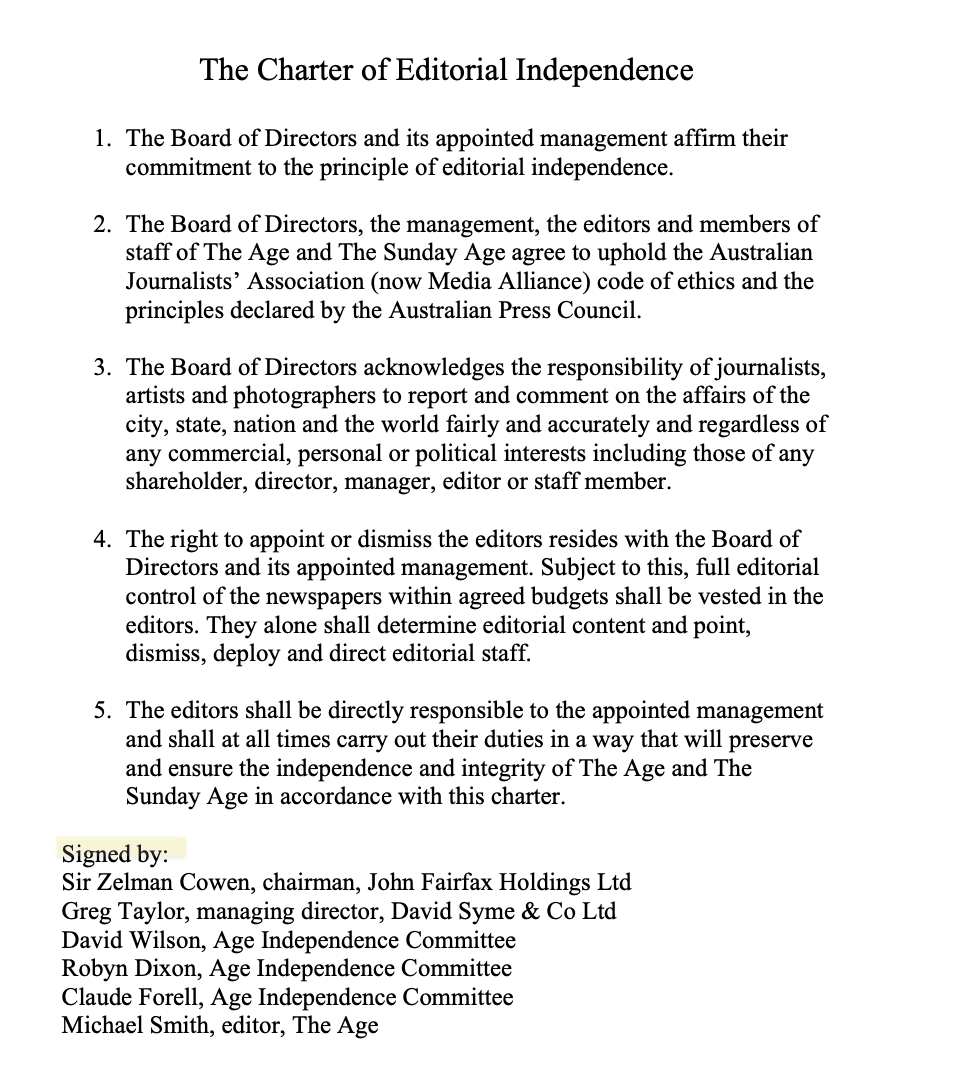
The former Fairfax Charter of Editorial Independence. Source: Supplied
Independent. Always?
The Klaxon’s revelations raise serious questions around Peter Costello.
The former long-time Federal Treasurer and senior LNP figure has been chairman of Nine since March 2016.
Having a conspicuously, closely politically aligned figure overseeing a major TV and media network has drawn serious concerns around governance and political interference since Costello’s appointment.
The Fairfax takeover threw petrol on the situation.
It has delivered Nine, already a major media player, enormous influence over the nation’s media and social discourse.
Adding yet further to concerns of politicisation of the former Fairfax mastheads, Costello has himself previously expressed his distaste for the Fairfax Charter of Independence.
In 2012 mining billionaire Gina Rinehart, who is Australia’s richest person and known for her “far-right” political views and opposition to climate action, was seeking to take a controlling stake in Fairfax.
That move was heavily opposed by Fairfax’s journalists, who saw it as a ploy by Rinehart to gain control of the papers in order to influence their coverage and so public opinion.
——————————————————
More on Nine:
Indigenous “group” created days before Nine’s Hanson stitch-up
Nine’s papers in major “independence” test: stumble hopelessly
SCOOP: Hanson’s Uluru “climb” a monolithic stitch up
———————————————————
Costello both publicly backed Rinehart and made a point of his distaste for the Fairfax Independence Charter.
“I did not sign the recent letter of ‘eminent people’ who wrote in support of the Fairfax charter of independence,” Costello said in mid-2012.
“The objection to Gina Rinehart is that she is the wrong type of person because she is, after all, a miner,” he said.
(Fairfax’s journalists strongly opposed the move and Rinehart ultimately abandoned it.)
Whether or not they can be definitively tied to Costello, it appears the concerns over political interference and the independence of the former Fairfax newspapers, post-takeover, were warranted.
In June almost 70 journalists from The Age expressed “alarm” over increasing politicisation of the paper under Nine executive editor James Chessell, including that editors were now putting pressure on reporters “to produce particular angles”.
In a letter to Chessell, The Age editor Alex Lavelle, and Nine chief publishing officer Chris Janz, the journalist warned the “proud reputation and independence” of the paper was under threat.
A “growing public perception” that the paper had become politicised was “damaging the reputation of The Age and, potentially, the viability of the business”.
The fact that nine months after the takeover, Nine ran a $10,000 a head, Liberal Party fundraiser – hosted by Nine CEO Marks – at its TV studios in Willoughby Sydney, did little to assuage those concerns.
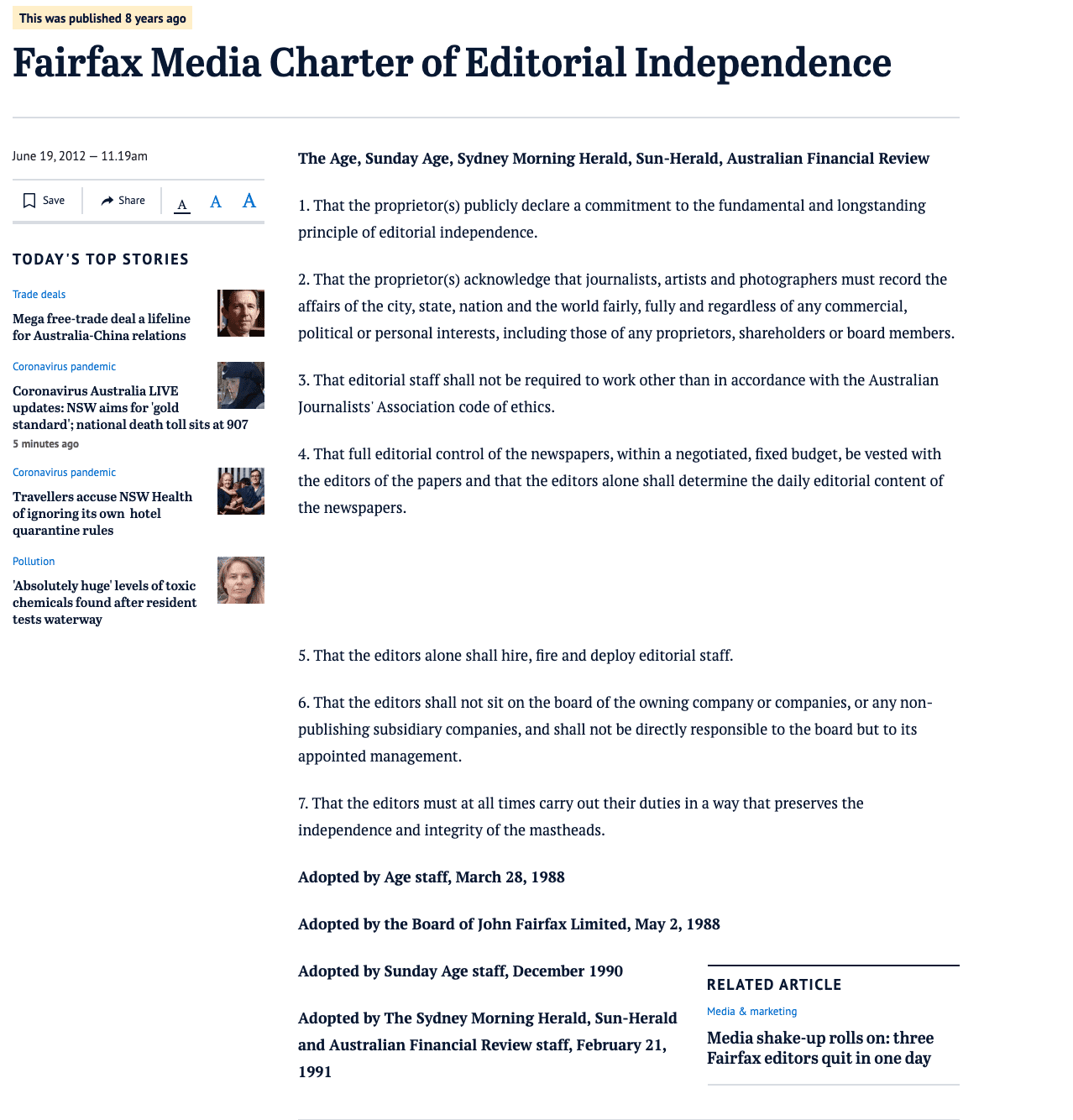
The former Fairfax Charter of Editorial Independence. Source: Supplied
Upshot
In our wrangling with Nine over the past two weeks, we have received various round-about statements regarding the Fairfax charter.
But we haven’t been provided with a single piece of evidence showing that the charter has been legally ratified by Nine in any way.
“Nine’s board adopted the Charter of Editorial Independence in 2018 and both the board and management continue to abide by it across all of our newspapers,” Nine spokesman Nic Christensen told The Klaxon last week.
However it’s just more weasel words.
This “adoption” was before Nine actually owned Fairfax, had any control over Fairfax, and had no relationship whatsoever with Fairfax journalists.
In light of everything else, Nine’s claims to “abide” by the charter (which in any event doesn’t actually legally exist), ring hollow.
All chairman Peter Costello would need to do to make sure the former Fairfax papers are covered by the former charter is to print off the Fairfax Charter of Independence above and sign his name at the bottom of it.
The great lengths to which Nine has gone in order to avoid doing this speaks volumes.
This week we asked Nine, that if there was indeed a charter of independence, how were Nine’s employees alerted to it and how were they informed of its contents in order for them to be able to abide by it?
For example, was the charter given to Nine employees when they started in the job? Does the charter exist on Nine’s intranet alongside Nine’s other policies?
No on both counts.
Nine sent us a link to an eight year old online article on The Sydney Morning Herald website.
“The charter accessible to both employees and readers here” Christensen wrote.
He continued:
“I know the SMH also has a large physical painting of the original charter of the Sydney Morning Herald (which echoes the more modern charter) on display in their newsroom and which has come with them on both moves since the merger.”
(An earlier version of this story quoted Costello as saying he had worked for Fairfax in the late 1990s. This is incorrect and based on an erroneous article, that conflated comments from Costello and those of another former LNP figure).
NEXT: Part Two. How Nine duped journalist union the Media, Entertainment and Arts Alliance.
Help us get the truth out from as little as $10/month.
Unleash the excitement of playing your favorite casino games from the comfort of your own home or on the go. With real money online casinos in South Africa, the possibilities are endless. Whether you’re into classic slots, progressive jackpots, or live dealer games, you’ll find it all at your fingertips. Join the millions of players enjoying the thrill of real money gambling and see if today is your lucky day!
The need for fearless, independent media has never been greater. Journalism is on its knees – and the media landscape is riddled with vested interests. Please consider subscribing for as little as $10 a month to help us keep holding the powerful to account.





